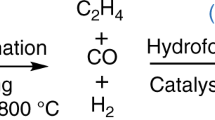Abstract
This paper reports on notable promotion of C2 + hydrocarbons formation from CO2 hydrogenation induced by combining Fe and a small amount of selected transition metals. Al2O3-supported bimetallic Fe–M (M = Co, Ni, Cu, Pd) catalysts as well as the corresponding monometallic catalysts were prepared, and examined for CO2 hydrogenation at 573 K and 1.1 MPa. Among the monometallic catalysts, C2 + hydrocarbons were obtained only with Fe catalyst, while Co and Ni catalysts yielded higher CH4 selectively than other catalysts. The combination of Fe and Cu or Pd led to significant bimetallic promotion of C2 + hydrocarbons formation from CO2 hydrogenation, in addition to Fe–Co formulation discovered in our previous work. CO2 conversion on Ni catalyst nearly reached equilibrium for CO2 methanation which makes this catalyst suitable for making synthetic natural gas. Fe–Ni bimetallic catalyst was also capable of catalyzing CO2 hydrogenation to C2 + hydrocarbons, but with much lower Ni/(Ni+Fe) atomic ratio compared to other bimetallic catalysts. The addition of a small amount of K to these bimetallic catalysts further enhanced CO2 hydrogenation activity to C2 + hydrocarbons. K-promoted Fe–Co and Fe–Cu catalysts showed better performance for synthesizing C2 + hydrocarbons than Fe/K/Al2O3 catalyst which has been known as a promising catalyst so far.

Similar content being viewed by others
References
Schwartz SE (2008) Uncertainty in climate sensitivity: causes, consequences, challenges. Energy Environ Sci 1:430–453
Song C (2006) Global challenges and strategies for control, conversion and utilization of CO2 for sustainable development involving energy, catalysis, adsorption and chemical processing. Catal Today 115:2–32
Markewitz P, Kuckshinrichs W, Leitner W, Linssen J, Zapp P, Bongartz R, Schreiber A, Muller TE (2012) Worldwide innovations in the development of carbon capture technologies and the utilization of CO2. Energy Environ Sci 5:7281–7305
Centi G, Perathoner S (2009) Opportunities and prospects in the chemical recycling of carbon dioxide to fuels. Catal Today 148:191–205
Wang W, Wang S, Ma X, Gong J (2011) Recent advances in catalytic hydrogenation of carbon dioxide. Chem Soc Rev 40:3703–3727
Jiang Z, Xiao T, Kuznetsov VL, Edwards PP (2010) Turning carbon dioxide into fuel. Philos Trans R Soc A 368:3343–3364
Song CS, Gaffney AM, Fujimoto K (eds) (2002) CO2 Conversion and Utilization. ACS Symposium Series, vol. 809. American Chemical Society, Washington, DC, 420 pp
Mikkelsen M, Jorgensen M, Krebs FC (2010) The teraton challenge. A review of fixation and transformation of carbon dioxide. Energy Environ Sci 3:43–81
Weatherbee GD, Bartholomew CH (1984) Hydrogenation of CO2 on group VIII metals: IV. specific activities and selectivities of silica-supported Co, Fe, and Ru. J Catal 87:352–362
Prairie MR, Renken A, Highfield JG, Thampi KR, Grätzel M (1991) A fourier transform infrared spectroscopic study of CO2 methanation on supported ruthenium. J Catal 129:130–144
Yesgar PW, Sheintuch M (1991) Nickel-catalyzed methanation reactions studied with an in situ magnetic induction method: experiments and modeling. J Catal 127:576–594
Riedel T, Schulz H, Schaub G, Jun K-W, Hwang J-S, Lee K-W (2003) Fischer–Tropsch on Iron with H2/CO and H2/CO2 as synthesis gases: the episodes of formation of the Fischer–Tropsch regime and construction of the catalyst. Top Catal 26:41–54
Du G, Lim S, Yang Y, Wang C, Pfefferle L, Haller GL (2007) Methanation of carbon dioxide on Ni-incorporated MCM-41 catalysts: the influence of catalyst pretreatment and study of steady-state reaction. J Catal 249:370–379
Dorner RW, Hardy DR, Williams FW, Davis BH, Willauer HD (2009) Influence of gas feed composition and pressure on the catalytic conversion of CO2 to hydrocarbons using a traditional cobalt-based Fischer–Tropsch catalyst. Energy Fuels 23:4190–4195
Riedel T, Claeys M, Schulz H, Schaub G, Nam S–S, Jun K-W, Choi M-J, Kishan G, Lee K-W (1999) Comparative study of Fischer–Tropsch synthesis with H2/CO and H2/CO2 syngas using Fe- and Co-based catalysts. Appl Catal A 186:201–213
Gnanamani MK, Shafer WD, Sparks DE, Davis BH (2011) Fischer–Tropsch synthesis: effect of CO2 containing syngas over Pt promoted Co/γ-Al2O3 and K-promoted Fe catalysts. Catal Commun 12:936–939
Nam S–S, Kim H, Kishan G, Choi M-J, Lee K-W (1999) Catalytic conversion of carbon dioxide into hydrocarbons over iron supported on alkali ion-exchanged Y-zeolite catalysts. Appl Catal A 179:155–163
Choi PH, Jun K-W, Lee S-J, Choi M-J, Lee K-W (1996) Hydrogenation of carbon dioxide over alumina supported Fe-K catalysts. Catal Lett 40:115–118
Xu L, Bao S, Houpt DJ, Lambert SH, Davis BH (1997) Role of CO2 in the initiation of chain growth and alcohol formation during the Fischer-Tropsch synthesis. Catal Today 36:347–355
Lee S-C, Kim J-S, Shin WC, Choi M-J, Choung S-J (2009) Catalyst deactivation during hydrogenation of carbon dioxide: effect of catalyst position in the packed bed reactor. J Mol Catal A 301:98–105
Dorner RW, Hardy DR, Williams FW, Willauer HD (2010) K and Mn doped iron-based CO2 hydrogenation catalysts: detection of KAlH4 as part of the catalyst’s active phase. Appl Catal A 373:112–121
Dorner RW, Hardy DR, Williams FW, Willauer HD (2011) C2–C5 + olefin production from CO2 hydrogenation using ceria modified Fe/Mn/K catalysts. Catal Commun 15:88–92
Satthawong R, Koizumi N, Song C, Prasassarakich P (2013) Bimetallic Fe–Co catalysts for CO2 hydrogenation to higher hydrocarbons. J CO2 Utilization. doi:10.1016/j.jcou.2013.10.002
Ishihara T, Eguchi K, Arai H (1987) Hydrogenation of carbon monoxide over SiO2-supported Fe–Co, Co–Ni and Ni-Fe bimetallic catalysts. Appl Catal 30:225–238
Cubeiro ML, Morales H, Goldwasser MR, Pérez-Zurita MJ, González-Jiménez F (2000) Promoter effect of potassium on an iron catalyst in the carbon dioxide hydrogenation reaction. React Kinet Catal Lett 69:259–264
Acknowledgments
This research is supported in part by the Pennsylvania State University through Penn State Institutes of Energy and the Environment. The authors also wish to thank the Thailand Research Fund and Graduate School of Chulalongkorn University through the Royal Golden Jubilee Ph.D. Program Scholarship to RS at PSU.
Author information
Authors and Affiliations
Corresponding author
Rights and permissions
About this article
Cite this article
Satthawong, R., Koizumi, N., Song, C. et al. Comparative Study on CO2 Hydrogenation to Higher Hydrocarbons over Fe-Based Bimetallic Catalysts. Top Catal 57, 588–594 (2014). https://doi.org/10.1007/s11244-013-0215-y
Published:
Issue Date:
DOI: https://doi.org/10.1007/s11244-013-0215-y




